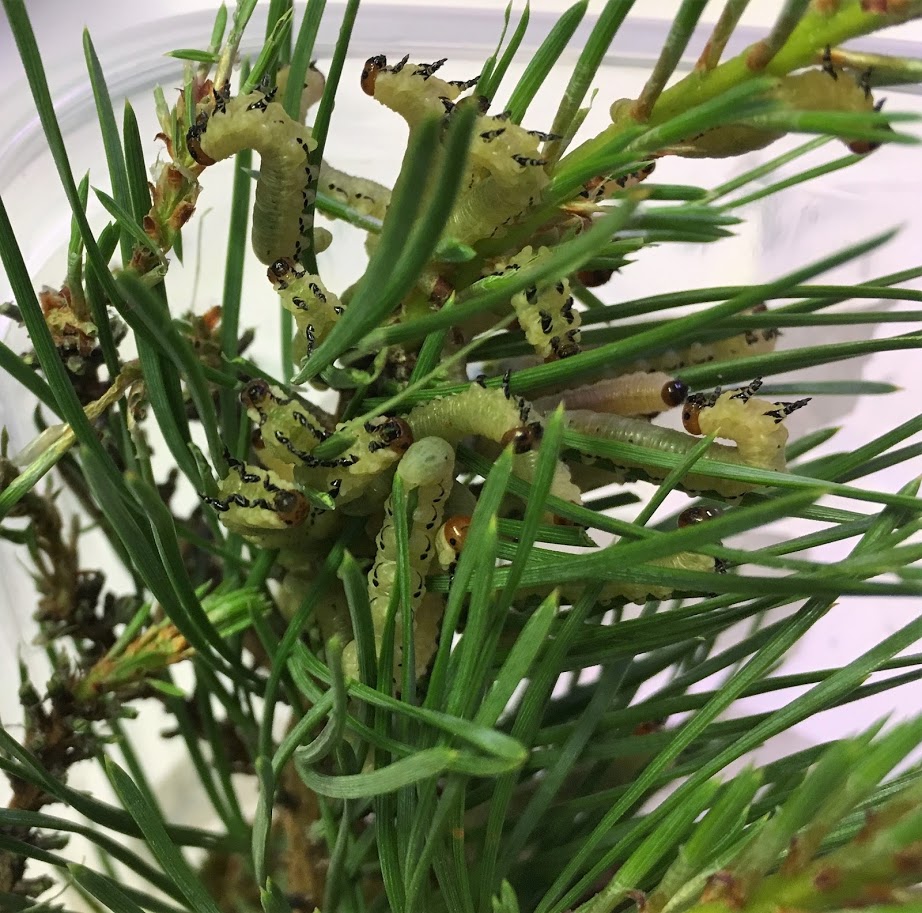 Evolution & Behaviour
Evolution & Behaviour
The conundrum of spontaneous (un)cooperation in pine sawflies
Would you puke to save your group? The dramatic group defence of the common pine sawfly (Diprion pini) larvae can help us understand why individuals do not always use their full potential to cooperate with others. Our study suggests that interactions between species determine how costly it is to cooperate.

It might seem that there is always someone who works a little less than others in a group. Especially if the participation in a collective effort comes with a price. This may be the case with groups of people aiming at a common goal and is widely detected with other organisms in nature as well. Perhaps surprisingly, the behaviour of the common pine sawfly (Diprion pini) can help us understand why individuals do not always use their full potential to cooperate with others in a group and what is the price of cooperation.
One of the key puzzles that evolutionary biologists aim to solve is when and why organisms should cooperate with other members of their species, and when and why they choose not to.
Fortunately, the group-dwelling lifestyle of the common pine sawfly (D. pini) offers a good opportunity to study what affects cooperative behaviour in nature. Larvae of this species live in large groups on pine trees, and collectively defend themselves against predators and parasites. The higher the proportion of defending individuals is, the more protected all group members should be from attacks by their enemies, such as birds and parasitoids.
When threatened, the common pine sawfly larvae exhibit a striking defence display by arching their back and regurgitating (i.e. throwing up) a resinous bubble of sticky defence fluid that they have stored in their defensive glands. All of this happens in concert with other members of the larval group. Or as is the case sometimes, with the exception of some individuals not participating in this cooperative effort.
In our study, we found that participation in this common defence is costly for the larvae. We studied this by simulating repetitive predator attacks on selected individuals and monitoring their performance and immune responses. Consequently, we found that the larvae pay a significant price for defending. Larvae that were forced to defend on a daily basis were more likely to die before they reach the pupal stage, and also had a weaker ability to defend themselves in future encounters with predators and parasites, compared to the control group. For example, the regularly defending larvae produced less and weaker defence fluid than their controls.
We also found that the "willingness" to participate in the common defence, and how costly it was for the larvae, depended on the chemical content of the larvae's diet. We found that for example, having to defend regularly reduced the immune responses of larvae only when the larvae fed on pine needles with a high resin content. Host plant quality of pine sawflies also varies widely in nature. Thus, these manipulated conditions simulated natural ecological interactions faced by pine sawflies. Therefore, our study shows that these different interactions jointly determine how many cooperators and free-riders there are in pine sawfly groups.
Finally, we found that irrespective of the manipulated conditions, male larvae were always more likely to be freeloaders in group defence than their sisters. Males also clearly benefited from their "cheating" as non-defending male larvae grew faster than males participating in the defence more often.
These results shed light on why it can be beneficial to cheat in a group effort. Non-defending, or "cheating", larvae in our study may have done so to save energy. These cheats directly benefited from it by growing faster. In addition, larvae that were forced to defend less often than their peers had a better capacity to defend themselves in future encounters against predators and parasites. Host plant quality combined with attack rate, i.e. interactions between different species, had a large impact on these costs.
To conclude, our results suggest that to solve how cooperation is maintained among members of the same species, we need information also about the interactions between species. This is because these interactions regulate how costly it is to cooperate, which in turn affects the frequency of cheats and cooperators in prey animals such as pine sawflies.
Original Article:
C. Lindstedt et al., Ecological conditions alter cooperative behaviour and its costs in a chemically defended sawfly. Proc Biol Sci 285, (2018)Edited by:
Massimo Caine , Founder and Director
We thought you might like
Genes coordinating selfishness and altruism between parents and offspring
Jan 11, 2021 in Psychology | 4 min read by Min WuI know you are calling me! – Fickle cats know their own names
Jan 19, 2021 in Psychology | 3.5 min read by Atsuko Saito , Kazutaka ShinozukaMore than money: what do we need to adapt to climate change?
Apr 22, 2021 in Evolution & Behaviour | 3.5 min read by Michele L. Barnes , Jacqueline LauSleepiness can disturb our social life
Apr 28, 2021 in Psychology | 3 min read by Tina Sundelin , Benjamin C. Holding , John AxelssonMore from Evolution & Behaviour
Cicada emergence alters forest food webs
Jan 31, 2025 in Evolution & Behaviour | 3.5 min read by Martha Weiss , John LillSize does not matter: direct estimations of mutation rates in baleen whales
Jan 29, 2025 in Evolution & Behaviour | 4 min read by Marcos Suárez-MenéndezThe Claws and the Spear: New Evidence of Neanderthal-Cave Lion Interactions
Jan 22, 2025 in Evolution & Behaviour | 3.5 min read by Gabriele RussoA deep-sea spa: the key to the pearl octopus’ success
Jan 20, 2025 in Evolution & Behaviour | 3.5 min read by Jim BarryFeisty fish and birds with attitude: Why does evolution not lead to identical individuals?
Aug 31, 2024 in Evolution & Behaviour | 3 min read by Lukas Eigentler , Klaus Reinhold , David KikuchiEditor's picks
Trending now
Popular topics


